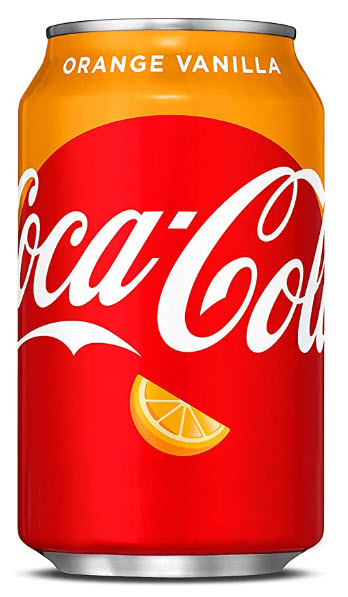
Coca-Cola has been around since 1892, when it was invented in Atlanta, GA, by Dr. John Pemberton, who served the refreshing new drink at his pharmacy in the city. With plenty of sugar, carbonated water, caramel color, and a few other ingredients, Coca-Cola was a hit. However, it is primarily thanks to the caffeine in Coke that many loved the stuff as it gave them a boost of energy and focus.
You likely know the rest of the story about Coke’s meteoric rise to the top of the soft drink pyramid, where it has stayed for over 120 years. Today the company makes a wide variety of soft drinks, including Coca-Cola Orange Vanilla. Like “classic” Coca-Cola, Coca-Cola Orange Vanilla has 34 milligrams of caffeine to help you get your day started. If you’d like to find out more, including how Coca-Cola Orange Vanilla stacks up to other soft drinks in terms of caffeine content, read on!

How Much Caffeine Do Soft Drinks Contain?
The word “soft drink” was more or less invented because of Coca Cola and today, there are dozens of soft drinks on store shelves. They’re called “soft” drinks because, years ago, people needed a way to distinguish these new drinks from “hard” drinks like whisky, beer, and wine.
Coke started with the kola nut, which is partly where its name came from and 100% where its caffeine came from. Today, caffeine is part of Coca-Cola’s recipe and many other soft drinks. Some soft drinks, however, are made without caffeine. Ginger ale, for example, has no caffeine, nor does Fanta and several others.

Caffeine Content
Coca-Cola Orange Vanilla vs. Other Soft Drinks
If you’re curious how Coca-Cola Orange Vanilla compares to other popular soft drinks in terms of caffeine, the chart below shows the caffeine content of many popular soft drinks.
| Soft Drink | Caffeine per can (12-ounce) |
| Coca-Cola Orange Vanilla | 34 milligrams |
| Coca-Cola | 34 milligrams |
| Mountain Dew | 55 milligrams |
| Diet Coke | 46 milligrams |
| Sprite | 6 milligrams |
| 7 UP | 6 milligrams |
| Dr.Pepper | 41 milligrams |
| Ginger ale | 0 milligrams |
| Caffeine-Free Diet Coke | 0 milligrams |
Coca-Cola Orange Vanilla vs. Coffee and Coffee Drinks
While you might not be drinking Coca-Cola Orange Vanilla as a replacement for coffee, both have caffeine, which is why many people love them. The question is, how does the caffeine content of Coca-Cola Orange Vanilla match up against your favorite coffee drinks? To find out, check out the table below.
| Caffeinated Drink | Caffeine per serving |
| Coca-Cola Orange Vanilla | 34 mg |
| Regular Brewed Coffee | 40–80 mg |
| Decaffeinated Coffee | 2–12 mg |
| Instant (powdered) Coffee | 40–80 mg |
| Regular Espresso | 250–300 mg |
| Regular Cappuccino | 150–170 mg |
| Regular Latte | 160–170 mg |
| Iced Coffee (average) | 40–60 mg |
| Cold Brew Coffee (average) | 180–200 mg |
https://www.instagram.com/p/CbezPVpJ43D/
What Are Soft Drinks?
You’ve probably heard the term “soft drink” many times, as it’s been used for over a hundred years to describe beverages without alcohol. What’s fascinating is that, in the early part of the 20th century, Americans were drinking a lot of alcohol. At the time, it was one of the safest liquids to drink, besides water and milk, which were often unavailable.
When Coca-Cola arrived on the scene, a term was needed to describe it so that customers would know it did not contain alcohol. For that reason, the term soft drink was invented and has stuck around. Today a soft drink is any carbonated drink that contains sugar, which includes Coca-Cola, Sprite, RC Cola, and more.
Fun Facts About Soft Drinks Like Coca-Cola Orange Vanilla
- Coca-Cola is the world’s most widely spread product and the world’s best-selling soft drink.
- Carbon escapes through plastic, so soft drinks in glass bottles always taste a little better and have more fizz than those in plastic bottles.
- In the 1920s through the 1940s, 7-Up contained the mood-stabilizing drug lithium citrate. However, the drug was banned from being used in soft drinks in 1948.
- The first soft drink that made it to space was Coca-Cola; it was on the Space Shuttle Challenger’s 1985 space mission.
- When first created, root beer was called root tea because it was brewed from the roots of several plants, including sassafras, sarsaparilla, and others. In the 1920s, during prohibition, root beer became a national hit and has been popular ever since.
- There is a turkey and gravy soda made by Jones Soda Co. and many other soft drinks with odd and interesting flavors.

Final Thoughts
As we’ve learned, Coca-Cola Orange Vanilla has 34 milligrams of caffeine, a relatively low amount compared to many of today’s popular energy drinks, which often contain 200 milligrams or more. That amount of caffeine is also lower than most caffeinated drinks, especially espresso, cappuccino, and cold brew coffee. Coca-Cola Orange Vanilla is made in the classic soft drink vein and has the same caffeine content (low) as its parent product. If a tasty soft drink with a slight caffeine kick is what you’re looking for, Coca-Cola Orange Vanilla is a terrific choice.
See Also:
Featured Image Credit: Amazon















